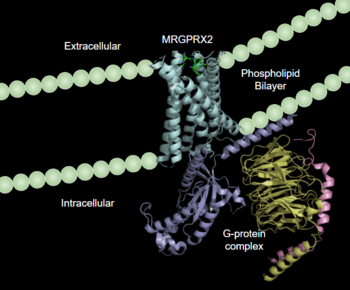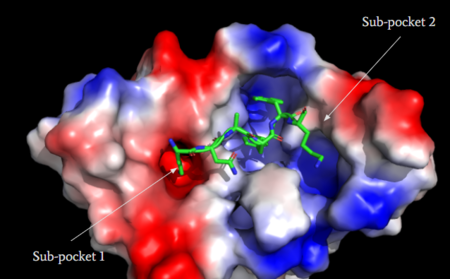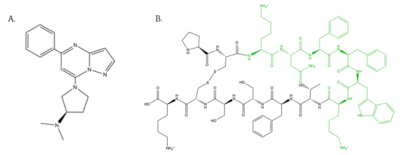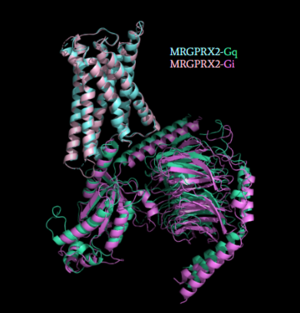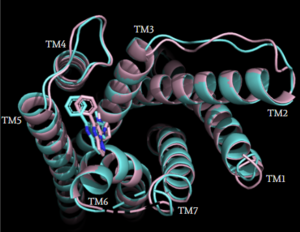Sandbox Reserved 1723
From Proteopedia
(Difference between revisions)
| Line 1: | Line 1: | ||
{{Template:CH462_Biochemistry_II_2022}}<!-- PLEASE ADD YOUR CONTENT BELOW HERE --> | {{Template:CH462_Biochemistry_II_2022}}<!-- PLEASE ADD YOUR CONTENT BELOW HERE --> | ||
| - | == '''''Human Itch | + | == '''''Human Itch Mas-Related G-Protein Coupled Receptor''''' == |
<StructureSection load='' size='350' frame='true' side='right' caption='Structure of MRGPRX2 with transmembrane helices shown in blue, Gαq shown in purple, Gβ1 shown in yellow, and Gγ2 shown in pink (PDB entry [https://www.rcsb.org/structure/7S8L 7S8L])' scene='90/904327/Overviewfrontpage/1'> | <StructureSection load='' size='350' frame='true' side='right' caption='Structure of MRGPRX2 with transmembrane helices shown in blue, Gαq shown in purple, Gβ1 shown in yellow, and Gγ2 shown in pink (PDB entry [https://www.rcsb.org/structure/7S8L 7S8L])' scene='90/904327/Overviewfrontpage/1'> | ||
| Line 8: | Line 8: | ||
== G-Protein Coupled Receptors == | == G-Protein Coupled Receptors == | ||
| - | [https://proteopedia.org/wiki/index.php/G_protein-coupled_receptors G-protein coupled receptors](GCPRs) are a large family of cell surface membrane receptors. Once bound to a wide variety of extracellular ligands, GCPRs undergo a conformational change and relay information to intracellular secondary messengers <ref name="Thal">Thal, David M., et al. "Structural insights into G-protein-coupled receptor allostery." Nature, Nature Publishing Group, 04 July 2018, https://www.nature.com/articles/s41586-018-0259-z</ref>. This G protein activation results in a cellular response dependent on the ligand bound and location of the GPCR in the body. GCPRs can be broken down into five families: the [https://en.wikipedia.org/wiki/Rhodopsin-like_receptors rhodopsin family (class A)], the [https://en.wikipedia.org/wiki/Secretin_receptor_family secretin family (class B)], the [https://en.wikipedia.org/wiki/Adhesion_G_protein-coupled_receptor adhesion family], the [https://en.wikipedia.org/wiki/Class_C_GPCR glutamate family (class C)], and the frizzled/taste family (class F) <ref name="Zhang">PMID: 26467290</ref>. All of the families have a similar transmembrane (TM) domain consisting of seven <scene name='90/904328/7tm_domain_pt_3/7'>α-helices</scene> complexed with intracellular G proteins. | + | [https://proteopedia.org/wiki/index.php/G_protein-coupled_receptors G-protein coupled receptors](GCPRs) are a large family of cell surface membrane receptors. Once bound to a wide variety of extracellular ligands, GCPRs undergo a conformational change and relay information to intracellular secondary messengers <ref name="Thal">Thal, David M., et al. "Structural insights into G-protein-coupled receptor allostery." Nature, Nature Publishing Group, 04 July 2018, https://www.nature.com/articles/s41586-018-0259-z</ref>. This G protein activation results in a cellular response dependent on the ligand bound and location of the GPCR in the body. GCPRs can be broken down into five families: the [https://en.wikipedia.org/wiki/Rhodopsin-like_receptors rhodopsin family (class A)], the [https://en.wikipedia.org/wiki/Secretin_receptor_family secretin family (class B)], the [https://en.wikipedia.org/wiki/Adhesion_G_protein-coupled_receptor adhesion family], the [https://en.wikipedia.org/wiki/Class_C_GPCR glutamate family (class C)], and the [https://en.wikipedia.org/wiki/Frizzled frizzled/taste family (class F)] <ref name="Zhang">PMID: 26467290</ref>. All of the families have a similar transmembrane (TM) domain consisting of seven <scene name='90/904328/7tm_domain_pt_3/7'> 7 α-helices</scene> complexed with intracellular G proteins (Figure 1). |
=== Class A GCPRs === | === Class A GCPRs === | ||
| - | Class A GPCRS or [https://en.wikipedia.org/wiki/Rhodopsin-like_receptors rhodopsin-like GPCRS] are the largest and most studied type of GPCRS. Due to the diversity of these receptors they are found in many aspects of physiology. For example, in skin, liver, and kidney diseases. They are characterized by conserved motifs including DRY, PIF, Sodium Binding, and the CWxP <ref name="Zhou">PMID: 31855179</ref>. A common example of a class A GPCRS is the [https:// | + | Class A GPCRS or [https://en.wikipedia.org/wiki/Rhodopsin-like_receptors rhodopsin-like GPCRS] are the largest and most studied type of GPCRS. Due to the diversity of these receptors they are found in many aspects of physiology. For example, in skin, liver, and kidney diseases. They are characterized by conserved motifs including DRY, PIF, Sodium Binding, and the CWxP <ref name="Zhou">PMID: 31855179</ref>. A common example of a class A GPCRS is the [https://proteopedia.org/wiki/index.php/Beta-2_Adrenergic_Receptor#:~:text=Beta%2D2%20Adrenergic%20Receptors%20(B2ARs,with%20over%201000%20unique%20Isoforms. β2AR receptor]. |
=== MRGPRs === | === MRGPRs === | ||
| - | The human itch GPCR, or Mas-related G-protein coupled receptor (MRGPR), is a Class A GPCR found in human sensory neurons and is responsible for the sensation of | + | The human itch GPCR, or Mas-related G-protein coupled receptor (MRGPR), is a Class A GPCR found in human sensory neurons and is responsible for the sensation of “[https://en.wikipedia.org/wiki/Itch itching]” caused by skin irritation and diseases, insect bites, and hypersensitivity to certain drugs. MRGPR's are broken into 4 groups consisting of MRGPRX1, MRGPRX2, MRGPRX3, and MRGPRX4. MRGPRX4 is responsible for [https://en.wikipedia.org/wiki/Cholestatic_pruritus#:~:text=Cholestatic%20pruritus%20is%20the%20sensation,pruritus)%2C%20and%20chronic%20hepatitis%20C cholestatic itching], an intense itching felt during pregnancy on the soles of the feet and palms of hands. Meanwhile, MRGPRX2 regulates [https://en.wikipedia.org/wiki/Degranulation degranulation] and [https://en.wikipedia.org/wiki/Hypersensitivity#:~:text=Hypersensitivity%20(also%20called%20hypersensitivity%20reaction,may%20be%20damaging%20and%20uncomfortable. hypersensitivity] itch reactions <ref name="Cao">Cao, Can, et al. "Structure, function and pharmacology of human itch GPCRs." Nature, Nature Publishing Group, 17 November 2021, https://www.nature.com/articles/s41586-021-04126-6</ref>. These two, chiefly MRGPRX2, are often targets for drugs that result in mast cell degranulation and hypersensitivity side effects, such as swelling and itching. In comparison to other Class A GPCRs, MRGPRX2 binds to an even wider range of ligands, including agonists such as cationic small molecules and peptide ligands. |
== Changes in MRGPRX2 from Standard Class A GPCRS == | == Changes in MRGPRX2 from Standard Class A GPCRS == | ||
| Line 26: | Line 26: | ||
==== ''Disulfide bonds'' ==== | ==== ''Disulfide bonds'' ==== | ||
| - | In common Class A GPCRs the disulfide bond associated with the initiation of signal transduction is located on the extracellular domain of the 7 transmembrane helices. <ref name="Zhang">PMID: 26467290</ref> The <scene name='90/904327/B2ardisulfidebond1_pt_3/1'>disulfide bond of β2AR </scene>, a well studied Class A GPCR, occurs between transmembrane three (TM3) C106 and extracellular loop (EL) C191. This loop crosses through the middle of the extracellular domain, creating a barrier for bulkier substrates. | + | In common Class A GPCRs the disulfide bond associated with the initiation of signal transduction is located on the extracellular domain of the 7 transmembrane helices. <ref name="Zhang">PMID: 26467290</ref> The <scene name='90/904327/B2ardisulfidebond1_pt_3/1'>disulfide bond of β2AR </scene>, a well studied Class A GPCR, occurs between transmembrane three (TM3) C106 and extracellular loop (EL) C191. This loop crosses through the middle of the extracellular domain, creating a barrier for bulkier substrates. The <scene name='90/904328/7tm_domain_pt_6/1'> MRGPRX2 disulfide bond</scene> is located between (TM4) C168 and (TM5) C180. This is a TM to TM disulfide bond as compared to a TM to EL disulfide bond seen in typical Class A GPCRs. This lack of interaction with the extracellular loop seen in MRGPRX2 causes the extracellular loop to flip on top of the TM4 and TM5 resulting in an open space for larger substrates to be able to interact with the receptor. |
==== ''PIF Motif'' ==== | ==== ''PIF Motif'' ==== | ||
| - | MRGPRX2 also differs from typical Class A GPCRs based on substitutions in the PIF/connector motif, which acts as a microswitch. PIF plays a role in connecting the binding pocket to conformational rearrangements required for receptor activation<ref name="Schonegge">Schonegge, Anne-Marie, et al. "Evolutionary action and structural basis of the allosteric switch controlling β2AR functional selectivity." Nature, Nature Publishing Group, 18 December 2017, https://www.nature.com/articles/s41467-017-02257-x</ref>. The PIF motif is located towards the base of the TM domains. In a Class A | + | MRGPRX2 also differs from typical Class A GPCRs based on substitutions in the PIF/connector motif, which acts as a microswitch. PIF plays a role in connecting the binding pocket to conformational rearrangements required for receptor activation<ref name="Schonegge">Schonegge, Anne-Marie, et al. "Evolutionary action and structural basis of the allosteric switch controlling β2AR functional selectivity." Nature, Nature Publishing Group, 18 December 2017, https://www.nature.com/articles/s41467-017-02257-x</ref>. The PIF motif is located towards the base of the TM domains. In a Class A GPCRs, the <scene name='90/904328/B2arpif_pt_2/1'> β2AR PIF motif</scene> consists of Phe-211, Ile-121, and Phe-282 on TM domains 5, 3, and 6, respectively. However, for MRGPRX2, this <scene name='90/904328/Mxpifnolabel_pt_3/1'>motif</scene> is replaced with Leu-194 on TM5, Leu-117 on TM3, and Phe-232 on TM6. |
==== ''DRY Motif'' ==== | ==== ''DRY Motif'' ==== | ||
| Line 51: | Line 51: | ||
[[Image:Agoniststogether.PNG |400px|right|thumb|'''Figure 3''': Structure of MRGPRX2 Agonists. (A) Structure of R-Zinc 3573. A cationic ligand selected for binding to MRGPRX2.<ref name="Yang">Yang, Fan, et al. "Structure, function and pharmacology of human itch receptor complexes." Nature, Nature Publishing Group, 17 November 2021, https://www.nature.com/articles/s41586-021-04077-y</ref> (B) Structure of Cortistatin-14 with resolved amino acids highlighted in green. These ligands were used as a probes for MRGPRX2 function and stabilization for structure determination.<ref name="Yang">Yang, Fan, et al. "Structure, function and pharmacology of human itch receptor complexes." Nature, Nature Publishing Group, 17 November 2021, https://www.nature.com/articles/s41586-021-04077-y</ref>]] | [[Image:Agoniststogether.PNG |400px|right|thumb|'''Figure 3''': Structure of MRGPRX2 Agonists. (A) Structure of R-Zinc 3573. A cationic ligand selected for binding to MRGPRX2.<ref name="Yang">Yang, Fan, et al. "Structure, function and pharmacology of human itch receptor complexes." Nature, Nature Publishing Group, 17 November 2021, https://www.nature.com/articles/s41586-021-04077-y</ref> (B) Structure of Cortistatin-14 with resolved amino acids highlighted in green. These ligands were used as a probes for MRGPRX2 function and stabilization for structure determination.<ref name="Yang">Yang, Fan, et al. "Structure, function and pharmacology of human itch receptor complexes." Nature, Nature Publishing Group, 17 November 2021, https://www.nature.com/articles/s41586-021-04077-y</ref>]] | ||
| - | ===== | + | ===== Small Molecule ===== |
| - | <scene name='90/904328/Zinc/4'>(R)-Zinc-3573</scene> is a cation ligand that selectively binds to MRGPRX2. Its N-dimethyl is inserted into subpocket 1 of the binding cavity with aromatic amino acid residues Phe-170, Trp-243, and Phe-244. In this<scene name='90/904328/Zizwithaa/4'>cavity</scene>, N-dimethyl group on the ligand makes ion pairs with Asp-184 and Glu-164. The ligand is then stabilized by stacking its ring with Trp-248 and the Cys-168 to Cys-180 disulfide bond <ref name="Yang">Yang, Fan, et al. "Structure, function and pharmacology of human itch receptor complexes." Nature, Nature Publishing Group, 17 November 2021, https://www.nature.com/articles/s41586-021-04077-y</ref>. | + | <scene name='90/904328/Zinc/4'>(R)-Zinc-3573</scene> is a cation ligand that selectively binds to MRGPRX2 (Figure 3). Its N-dimethyl is inserted into subpocket 1 of the binding cavity with aromatic amino acid residues Phe-170, Trp-243, and Phe-244. In this<scene name='90/904328/Zizwithaa/4'>cavity</scene>, N-dimethyl group on the ligand makes ion pairs with Asp-184 and Glu-164. The ligand is then stabilized by stacking its ring with Trp-248 and the Cys-168 to Cys-180 disulfide bond <ref name="Yang">Yang, Fan, et al. "Structure, function and pharmacology of human itch receptor complexes." Nature, Nature Publishing Group, 17 November 2021, https://www.nature.com/articles/s41586-021-04077-y</ref>. |
===== Peptide ===== | ===== Peptide ===== | ||
| - | <scene name='90/904328/Overview_x2_c_pt_3/4'>Cortistatin-14</scene> is one of the peptide ligands that binds to MRGPRX2. Cortistatin-14 interacts with the binding pocket through an <scene name='90/904328/Zic14_pt_3/4'>electrostatic</scene> interaction in sub-pocket 1 between Lys-3 on the peptide and Glu-164 and Asp-184 on MRGPRX2 <ref name="Cao"/>. Additionally, there are hydrophobic interactions in sub-pocket 2 between the peptide and the binding pocket due to the large hydrophobic amino acids on Cortistatin-14. | + | <scene name='90/904328/Overview_x2_c_pt_3/4'>Cortistatin-14</scene> is one of the peptide ligands that binds to MRGPRX2 (Figure 3). Cortistatin-14 interacts with the binding pocket through an <scene name='90/904328/Zic14_pt_3/4'>electrostatic</scene> interaction in sub-pocket 1 between Lys-3 on the peptide and Glu-164 and Asp-184 on MRGPRX2 <ref name="Cao"/>. Additionally, there are hydrophobic interactions in sub-pocket 2 between the peptide and the binding pocket due to the large hydrophobic amino acids on Cortistatin-14. |
=== 2. MRGPRX2 interaction with G-Protein === | === 2. MRGPRX2 interaction with G-Protein === | ||
[[Image:Gq_and_Gi_snip.PNG|300px|right|thumb|'''Figure 4''': Caption.<ref name="Cao"/>]] | [[Image:Gq_and_Gi_snip.PNG|300px|right|thumb|'''Figure 4''': Caption.<ref name="Cao"/>]] | ||
| - | Once the ligand is bound, MRGPRX2 undergoes a conformational change. This conformational change is affected by the aforementioned deviances from Class A GPCRs. Rather than a large conformational change, a subtle one is induced. This will allow MRGPRX2 to interact with a G-protein. G-proteins are composed of 3 subunits; α, β, and γ. When activated, the receptor acts as a Guanine nucleotide factor (GEF) which will allow the Gα subunit to have its GDP be replaced by a GTP. This will cause the Gα subunit to dissociate from the dimer Gβγ. The Gα subunit is then able to act as a secondary messenger to begin the signal transduction in the cell. MRGPRX2 interacts with two different types of G-proteins; Gi and Gq. These G-proteins are activated by similar interactions with the receptor however, they are structurally different and changes in the induced conformation are observed (Figure 6). Due to these structural differences, differences in ligand binding to MRGPRX2 bound to Gi in comparison to Gq are observed (Figure 5). | + | Once the ligand is bound, MRGPRX2 undergoes a conformational change that is transmitted through to the [https://en.wikipedia.org/wiki/G_protein#:~:text=G%20proteins%2C%20also%20known%20as,a%20cell%20to%20its%20interior. G-protein]. This conformational change is affected by the aforementioned deviances from Class A GPCRs. Rather than a large conformational change, a subtle one is induced. This will allow MRGPRX2 to interact with a G-protein. G-proteins are composed of 3 subunits; α, β, and γ. When activated, the receptor acts as a Guanine nucleotide factor (GEF) which will allow the Gα subunit to have its GDP be replaced by a GTP. This will cause the Gα subunit to dissociate from the dimer Gβγ. The Gα subunit is then able to act as a secondary messenger to begin the signal transduction in the cell. MRGPRX2 interacts with two different types of G-proteins; Gi and Gq. These G-proteins are activated by similar interactions with the receptor however, they are structurally different and changes in the induced conformation are observed (Figure 6). Due to these structural differences, differences in ligand binding to MRGPRX2 bound to Gi in comparison to Gq are observed (Figure 5). |
[[Image:GqGi_with_zincs_snip.PNG|300px|left|thumb|'''Figure 5''': Caption.<ref name="Cao"/>]] | [[Image:GqGi_with_zincs_snip.PNG|300px|left|thumb|'''Figure 5''': Caption.<ref name="Cao"/>]] | ||
| Line 78: | Line 78: | ||
MRGPRX2 activation is associated with chronic itching or anaphylaxis reactions, a common side effect of many prescribed medications. <ref name="Cao"/> Among these drugs are opiods [https://en.wikipedia.org/wiki/Morphine morphine] and [https://en.wikipedia.org/wiki/Codeine codeine] and [https://en.wikipedia.org/wiki/Dextromethorphan dextromethorphan]. By analyzing the structures of these drugs, it can be seen that they contain chemical features similar to agonist R-Zinc-3573 (see Figure 4). They contain a conserved benzene ring that stabilizes them in binding pocket one (See Figure 3). Similarly, they contain an N-dimethyl group that would allow them to form key bonds with residues Asp-184 and Glu-164. Lastly, these drugs have a similar shape and size to that of the agonist R-Zinc-3573.<ref name="Babina"> Babina, M., et al. "MRGPRX2 Is the Codeine Receptor of Human Skin Mast Cells: Desensitization through β-Arrestin and Lack of Correlation with the FcεRI Pathway." Journal of Investigative Dermatology, 141(6), 1286-1296. https://doi.org/10.1016/j.jid.2020.09.017</ref> These structural and chemical similarities indicate the possibility of a similar binding mechanism. | MRGPRX2 activation is associated with chronic itching or anaphylaxis reactions, a common side effect of many prescribed medications. <ref name="Cao"/> Among these drugs are opiods [https://en.wikipedia.org/wiki/Morphine morphine] and [https://en.wikipedia.org/wiki/Codeine codeine] and [https://en.wikipedia.org/wiki/Dextromethorphan dextromethorphan]. By analyzing the structures of these drugs, it can be seen that they contain chemical features similar to agonist R-Zinc-3573 (see Figure 4). They contain a conserved benzene ring that stabilizes them in binding pocket one (See Figure 3). Similarly, they contain an N-dimethyl group that would allow them to form key bonds with residues Asp-184 and Glu-164. Lastly, these drugs have a similar shape and size to that of the agonist R-Zinc-3573.<ref name="Babina"> Babina, M., et al. "MRGPRX2 Is the Codeine Receptor of Human Skin Mast Cells: Desensitization through β-Arrestin and Lack of Correlation with the FcεRI Pathway." Journal of Investigative Dermatology, 141(6), 1286-1296. https://doi.org/10.1016/j.jid.2020.09.017</ref> These structural and chemical similarities indicate the possibility of a similar binding mechanism. | ||
| - | This receptor is shallow and is able to bind to a variety of drugs, creating a need a solution to mediate the effects of MRGPRX2 activation. Currently, there is research for the development of small antagonists that will induce an anti-inflammatory effect by prevent IgE- | + | This receptor is shallow and is able to bind to a variety of drugs, creating a need a solution to mediate the effects of MRGPRX2 activation. Currently, there is research for the development of small antagonists that will induce an anti-inflammatory effect by prevent [https://en.wikipedia.org/wiki/Immunoglobulin_E IgE-dependent] mast cell degranulation.<ref name="McNeil">McNeil, B. D., et al. "MRGPRX2 and Adverse Drug Reactions." Frontier Immunology, 06 August 2021, https://www.frontiersin.org/articles/10.3389/fimmu.2021.676354/full</ref> There are two antagonists that have been adapted from being agonists to another Class A GPCR, [https://en.wikipedia.org/wiki/NK1_receptor_antagonist neurokinin-1 receptor (NK-1R)].<ref name="Ogasawara">Ogasawara, H., et al. "Novel MRGPRX2 antagonists inhibit IgE-independent activation of human umbilical cord blood-derived mast cells." Journal of Leukocyte Biology, 12 July 2019, https://jlb.onlinelibrary.wiley.com/doi/10.1002/JLB.2AB1018-405R</ref> Through the development of this research, these adverse side effects can be relieved and improve patient satisfaction. |
Revision as of 21:09, 20 April 2022
| This Sandbox is Reserved from February 28 through September 1, 2022 for use in the course CH462 Biochemistry II taught by R. Jeremy Johnson at the Butler University, Indianapolis, USA. This reservation includes Sandbox Reserved 1700 through Sandbox Reserved 1729. |
To get started:
More help: Help:Editing |
Human Itch Mas-Related G-Protein Coupled Receptor
| |||||||||||
References
- ↑ 1.0 1.1 1.2 1.3 1.4 1.5 1.6 1.7 1.8 1.9 Cao, Can, et al. "Structure, function and pharmacology of human itch GPCRs." Nature, Nature Publishing Group, 17 November 2021, https://www.nature.com/articles/s41586-021-04126-6
- ↑ Thal, David M., et al. "Structural insights into G-protein-coupled receptor allostery." Nature, Nature Publishing Group, 04 July 2018, https://www.nature.com/articles/s41586-018-0259-z
- ↑ 3.0 3.1 Zhang D, Zhao Q, Wu B. Structural Studies of G Protein-Coupled Receptors. Mol Cells. 2015 Oct;38(10):836-42. doi: 10.14348/molcells.2015.0263. Epub 2015, Oct 15. PMID:26467290 doi:http://dx.doi.org/10.14348/molcells.2015.0263
- ↑ 4.0 4.1 4.2 Zhou Q, Yang D, Wu M, Guo Y, Guo W, Zhong L, Cai X, Dai A, Jang W, Shakhnovich EI, Liu ZJ, Stevens RC, Lambert NA, Babu MM, Wang MW, Zhao S. Common activation mechanism of class A GPCRs. Elife. 2019 Dec 19;8. pii: 50279. doi: 10.7554/eLife.50279. PMID:31855179 doi:http://dx.doi.org/10.7554/eLife.50279
- ↑ 5.0 5.1 5.2 5.3 5.4 5.5 5.6 5.7 Yang, Fan, et al. "Structure, function and pharmacology of human itch receptor complexes." Nature, Nature Publishing Group, 17 November 2021, https://www.nature.com/articles/s41586-021-04077-y
- ↑ 6.0 6.1 Schonegge, Anne-Marie, et al. "Evolutionary action and structural basis of the allosteric switch controlling β2AR functional selectivity." Nature, Nature Publishing Group, 18 December 2017, https://www.nature.com/articles/s41467-017-02257-x
- ↑ Sandoval, A., et al. "The Molecular Switching Mechanism at the Conserved D(E)RY Motif in Class-A GPCRs." Biophysical journal, 111(1), 79-89. https://doi.org/10.1016/j.bpj.2016.06.004
- ↑ Katritch V, Fenalti G, Abola EE, Roth BL, Cherezov V, Stevens RC. Allosteric sodium in class A GPCR signaling. Trends Biochem Sci. 2014 May;39(5):233-44. doi: 10.1016/j.tibs.2014.03.002. Epub , 2014 Apr 21. PMID:24767681 doi:http://dx.doi.org/10.1016/j.tibs.2014.03.002
- ↑ Babina, M., et al. "MRGPRX2 Is the Codeine Receptor of Human Skin Mast Cells: Desensitization through β-Arrestin and Lack of Correlation with the FcεRI Pathway." Journal of Investigative Dermatology, 141(6), 1286-1296. https://doi.org/10.1016/j.jid.2020.09.017
- ↑ McNeil, B. D., et al. "MRGPRX2 and Adverse Drug Reactions." Frontier Immunology, 06 August 2021, https://www.frontiersin.org/articles/10.3389/fimmu.2021.676354/full
- ↑ Ogasawara, H., et al. "Novel MRGPRX2 antagonists inhibit IgE-independent activation of human umbilical cord blood-derived mast cells." Journal of Leukocyte Biology, 12 July 2019, https://jlb.onlinelibrary.wiley.com/doi/10.1002/JLB.2AB1018-405R
